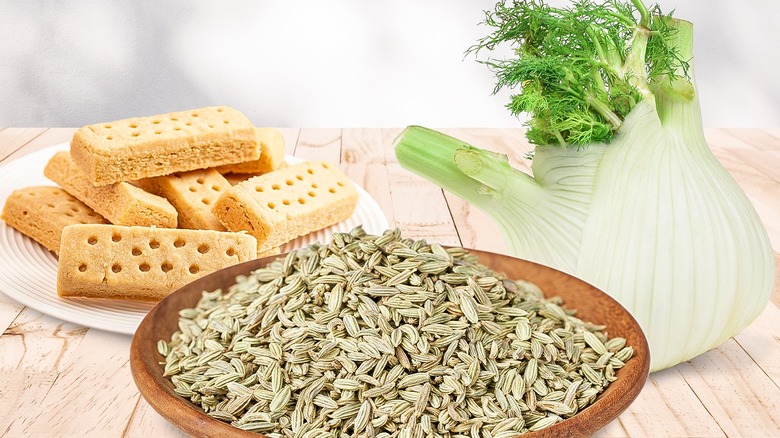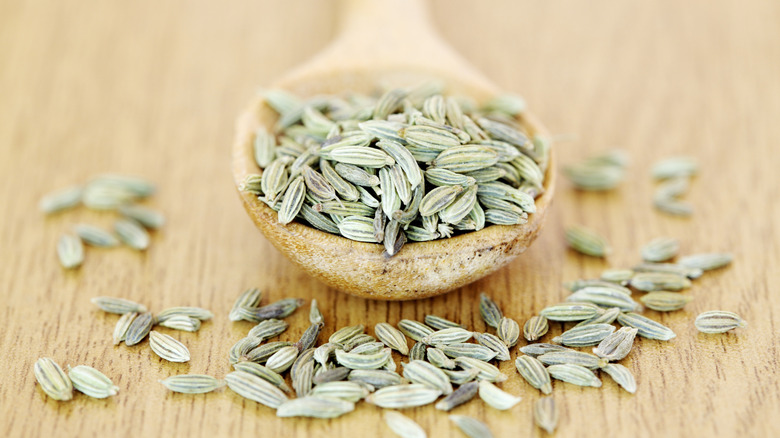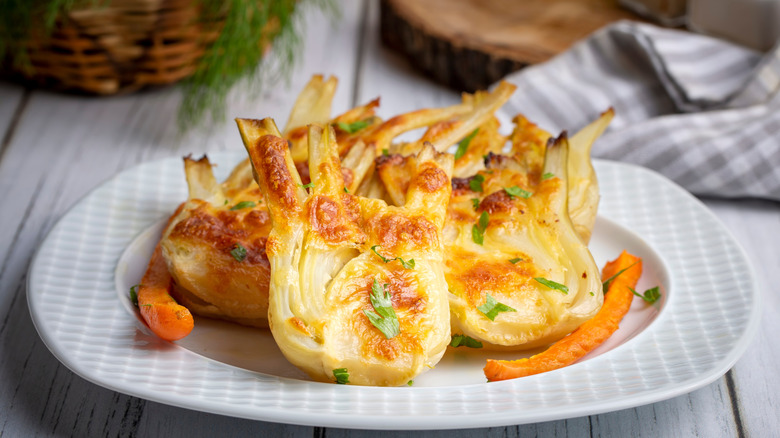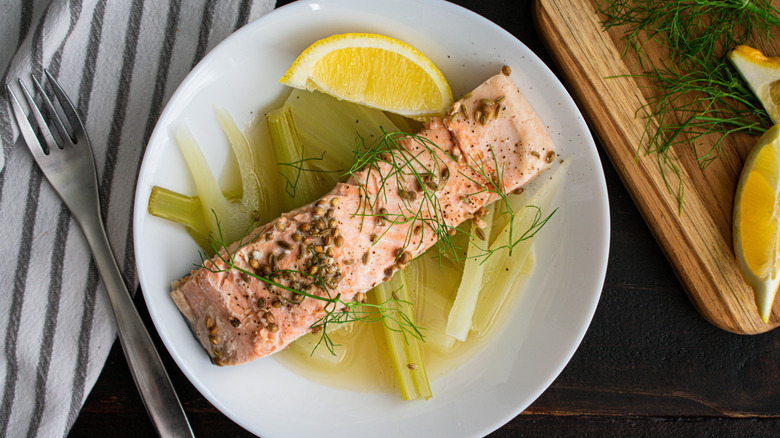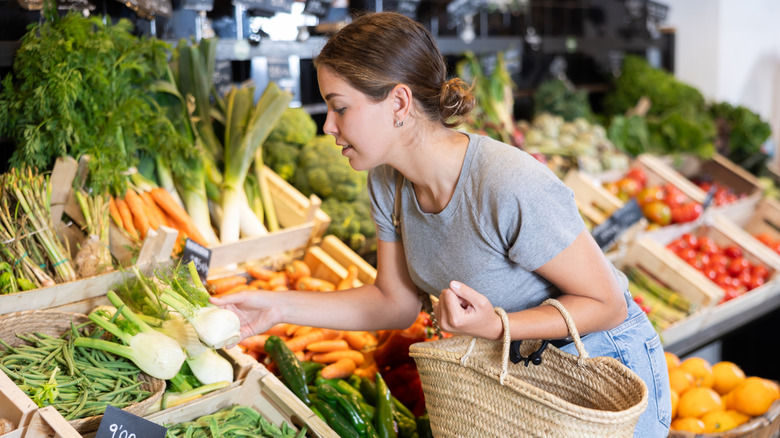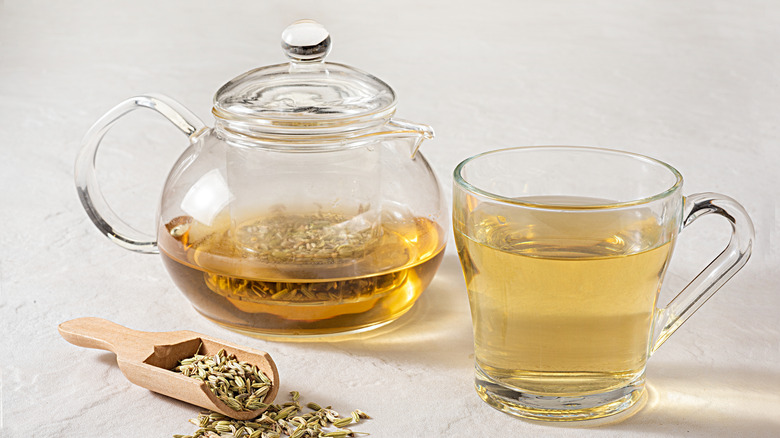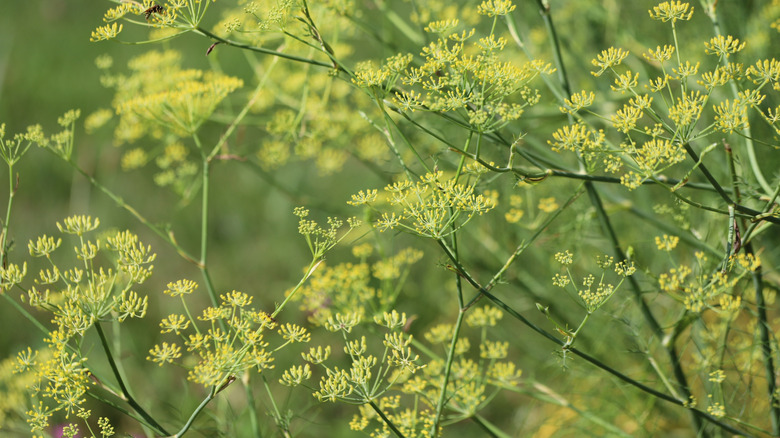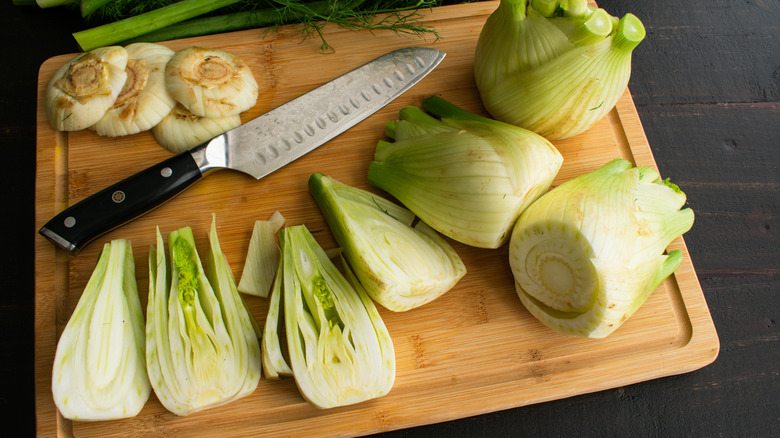Everything You Need To Know About Fennel
Fennel is one of those versatile, flavorful, and beautiful vegetables that often gets overlooked. When meandering the produce section, folks tend to gravitate toward their tried-and-true favorites like peppers, onions, potatoes, and green beans. Incorporating a new vegetable into your life can be intimidating if you don't know where to start. Heck, some of you may have never even heard of fennel before, and that's okay. It's not incredibly common in the standard American diet, but it has every right to be. Curiosity is the first step, and we will take care of the rest by laying out everything you need to know about fennel to get started. And hey, because it's unique, it can make any basic dish go from bland to gourmet in just moments. Your family and friends will be impressed and curious about that secret ingredient that made your dish pop.
As a recipe designer and chef with a certification from Cornell in plant-based nutrition, I believe it's critical for both our taste buds and our bodies to experiment with a variety of foods. In fact, according to the CDC only 1 in 10 Americans gets enough fruits and vegetables. Well, there is no time like the present to start incorporating new vegetables into your diet, and fennel is a great place to start. It's delicious, easy to work with, and great for your health. Say hello to your new favorite vegetable that will elevate your go-to recipes or inspire new ones.
What is fennel
Those hearing about fennel for the first time are not alone. Although it's often found in gourmet cuisine, it's not a particularly expensive or bougie vegetable. It's a simple root vegetable found in the carrot family. Its official botanical name is Foeniculum vulgare, and it's best described as looking like a lumpy, large onion with firm green stalks and dill-like lacey leaves. The bulb is generally the size of about two white onions, melded together, and the stalks can be quite tall. At the grocery store, you'll find fennel with stalks about a foot tall or less, but they can reach up to six feet tall. Fennel can be classified as an herb, a vegetable, and a spice because of all the plant has to offer, from root to flower.
Although fennel originated in Southern Europe, it has been cultivated around the world and has been used by many ancient and modern cultures in their cuisine and medicinal practices. In fact, fennel was used to remedy snake bites in Ancient China, and in the Middle Ages, some Europeans hung it over their doorways to ward off evil. Ancient Egyptians used the juice from a now-extinct variety as contraception. Its uses are endless, and who doesn't need to ward off a little evil in their lives? Even in modern America, where there is a prescription for everything, many folks still use fennel seeds and tea to soothe an upset stomach. However you choose to enjoy the plant, rest assured that it will enrich your body just as much as your palette.
Fennel root vs. fennel seeds
When you see "fennel" in a recipe, it could mean a variety of things. The chef could be referring to the bulb, which is the vegetable portion that resembles celery or onions. They could be referring to the spice, which is made from dried and ground seeds. If the measurement is in tablespoons or teaspoons, you can safely assume you're dealing with the seed. Be sure to note whether to use ground or whole seeds. If not specified, they are likely calling for whole seeds. Some recipes, like homemade sausage, indicate using a whole seed to add a burst of flavor when chewed rather than a consistency of flavor throughout.
Both the seeds and the root have a similar flavor but are used in different capacities. Often, fennel seeds are used for pickling purposes. Ever had pickled eggs with fennel seeds? What about pickled dilly beans? Do you know those long seeds at the bottom of a pickle jar floating around with mustard seeds and peppercorns? Those are fennel seeds and give the pickles an almost sweet, licorice-like flavor.
When the recipe calls for the vegetable portion of the plant, the expectation is that you'll buy it raw from the produce section. It comes with a bulb, stalks, and fronds. It's all edible, but typically, it's expected that the root or bulb is the main portion of the plant. It can be sliced and eaten raw or cooked. The bulb is often used in soups but can be roasted, grilled, or added to a stir-fry.
If you want to get creative, you can use the fronds and even the pollen as garnish. The fronds look similar to fresh, whole dill-weed and are lacy and delicate. Sprinkling pollen on a finished dish is an excellent creative use of whole vegetables. You might as well use every last bit of the plant and let nothing go to waste.
What does fennel taste like
Uncooked fennel has a mild anise-like flavor reminiscent of licorice. However, there are some major differences between fennel and anise. Anise is an herb without a bulb, so the two couldn't be more different in appearance below the dirt, but the tops do have some resemblance. Fennel has a more subtle sweet flavor that lingers, while anise is intense. It's often used in baked goods, licorice candies, or alcoholic beverages. Because fennel is milder, it's the perfect ingredient for subtle metallic sweetness reminiscent of tobacco rather than an overpowering flavor.
The bulb is even more mild than the seed. The intensity of the sweetness strengthens as the plant comes in contact with heat. Some folks describe raw fennel as having a faint bitterness to it, with a refreshing crunch similar to celery. Its herby undertones add complexity, and the flavors tend to linger on the tongue.
When fennel root is sauteed, it tends to reach peak sweetness. So, if you're looking to add dimension to your savory-sweet stir fry, you may consider this root vegetable. It can also be used as a pizza topping, a soup sweetener, or even layered into a casserole.
How to cook with fennel
All parts of the fennel plant can be eaten raw. Because it's rather fibrous, it's typically served thinly shaved. Cooking it can also break down those fibers, and there are endless delicious ways to use the fennel bulb in your cooking and recipes using fennel. Consider combining fennel with other light and subtly sweet flavors, like lemon. Other Mediterranean flavors such as olive, herbs, and potatoes play on the subtlety of the vegetable and help to enhance but not overpower its flavor.
Fennel is unique in the sense that it can pair beautifully with a white flakey fish but also with gamey lamb or quail. It's versatile and plays nicely with both powerful and mellow flavors. Cook in a sheet pan recipe with umami-rich cherry tomatoes and roasted garlic, or simmer it with white wine and lemons. It is rather sweet, so try pairing fennel with black pepper or other mild spicey flavors.
To get the most sweet notes out of your fennel root, start by searing it in a sauce pan in a little bit of hot oil, then transfer it to your recipe and continue the cooking process, whether it be in the oven or on the stovetop. Fennel can also be grilled over an open flame or even boiled. Just keep in mind that like with meat, that pre-cooking sear can make all the difference to texture and flavor. This is why braised fennel is so incredible and makes for a unique side dish or even main course.
Fennel root is a wonderful addition to homemade umami vegetable stock. Simply add a few large chunks along with your other vegetables, and remove them after the stock has simmered for quite a while. Homemade vegetable stock can be made with scraps, so any leftovers you have of the fennel, whether it's the fronds, the stalks, or the bulb, toss it in for a sweeter, more rounded broth.
The vegetable is rather large, so be sure you're cutting fennel the right way, because contrary to popular belief, how you cut your vegetables can affect the flavor. For safe-cutting practices, use a sharp knife and cut the fennel in half. Place the cut side down and dice it like you would an onion, or create thin slices. This way, you can ground the vegetable to the board, and you don't have to worry about movement or slipping. Use the fronds as garnish, or even make pesto with them. They are delicate enough to chop up and enjoy in a salad and are beautiful when floated atop a chilled soup. You can even mix them with cream cheese, sour cream, or other creamy and refreshing dips.
Where to buy fennel
Fennel seeds, or ground fennel seeds, are easy to find in the grocery store. Simply look in the spice aisle for fennel spice. It should be jarred and moss green. Spices should be bought as fresh as possible, even if they are dried, so be sure to check that expiration date.
Fennel bulbs can be found in the produce section of your grocery store. It's often stored near the fresh greens, carrots, and roots that get misted to stay moist. Not all fennel is the same, so know what to look for when buying fresh fennel. Like any vegetable at the grocery store, especially those that may not be quite as popular, fennel varies in freshness. The fresher the plant, the tighter the bulb is packed, and the whiter the coloring. If it has signs of yellowing, it's past its prime.
If you're more of a hands-on type, you can also tell by giving it a firm squeeze. It should not have give, similar to a carrot or celery. If you are finding that it's starting to splay apart or that the bulb is softening, then it's worth avoiding. Because there are different varieties of fennel, the size should not play a role in your decision-making unless you're zeroing in on a particular variety.
For those who may live in a farming town, try to grab fennel fresh from the farm stand or at your local farmers market. It's typically harvested from June through October, so you'll have plenty of chances to get your hands on the sweet vegetable. We love produce yanked right from the dirt, but if your bounty is still a little muddy, be thorough in cleaning. Like leeks, fennel has quite a few layers for dirt to get stuck in. Give it a solid rinse before cutting into it, and then rinse it again. Use a soft produce brush if need be, and if you still can't get the dirt off, then consider floating it in some water after it's cut. Slosh it around and let the dirt settle to the bottom of the sink or bin. Delicately remove the fennel that is floating at the surface, and that should help to separate the vegetable from the dirt.
Nutrition information about fennel
Throughout time, fennel has been used both as a culinary tool but also as a medicinal one. As we know, vegetables are often loaded with fiber, antioxidants, and a variety of vitamins that are beneficial to our health and development. Fennel is no exception, especially the seeds. The Journal of Food Biochemistry shows the vast potential of fennel as a health food because of its antioxidant and anti-inflammatory properties. It also is anti-fungal and anti-viral and can even help women produce more breastmilk through the stimulation of prolactin.
Because fennel is a high-fiber food, it helps to feed good gut bacteria, promoting a balanced and flourishing gut microbiome. A healthy gut does more than just help keep you regular. It can affect your heart and even your mental health. Speaking of guts, fennel is great for digestion. There is a reason that Indian restaurants often offer those colorful candy-coated fennel seeds. They are an incredible digestive aid and even help to freshen your breath. That's right, it's more than just a sweet treat to cap off your meal; it is there for health and comfort.
The root is also loaded with phosphates and calcium, iron and zinc, manganese, and vitamin K. It can help regulate blood pressure to keep your ticker going strong and can prevent inflammation, which makes it an anti-cancer. Wow, it's more than just a delicious vegetable or spice; it's a superhero food that can actually save your life through prevention when eaten consistently as part of a healthy, plant-rich diet.
Varieties of fennel
While many of us are still grasping the concept of what fennel is, veggie experts can start to explore different varieties of fennel. It's important to know what part of the plant you'd like to use when selecting the variety of fennel that will best benefit your recipe. There are three types of fennel to choose from.
The first is called Foeniculum vulgare var. Azoricum, known as "bulb fennel." This is typically the fennel you will find in the grocery store, and as its name indicates, it's primarily used for its root or bulb. This is the fennel that can be chopped up and sprinkled on your salad, thrown into the pan for a stir fry, simmered in soup or sauce, or roasted in the oven. Next is Foeniculum vulgare var. Dulce known as "sweet fennel". This is the variety that is harvested for its seeds. These seeds can be used as a spice, steeped into tea, or candy-coated for a sweet digestive aid.
Foragers, grab your baskets because lastly, we have Foeniculum vulgare var. vulgare, known as "wild fennel". This is fennel that typically grows in the wild, but you can certainly cultivate it yourself. The entire plant can be used, and often the seeds, flowers, and stems are boiled to make tea. It can also be eaten raw and is quite sweet, crunchy, and juicy. Although it's native to Southern Europe, primarily the Mediterranean, you can spot wild fennel all over the world. In fact, in California, it can be spotted growing in the woods, fields, and even on the side of the roads.
All three varieties are used for both culinary and medicinal purposes, although sweet fennel and wild fennel are more commonly harvested for their seeds. The seeds, like most plants, are nutritionally dense and most often used for medicinal properties.
How to store fennel
Depending on the part of the plant you are using, there are a variety of best practices for storing it. For storing fennel seeds, simply follow the rules you would for storing any dry spice. Keep it in an airtight container, and store it in a cool, dry space. This goes for both dried fennel seeds and ground fennel. Contrary to popular belief, spices don't last forever. They lose their potency, but unless moisture is introduced, expired spices are generally not harmful. It's best to consume dried spices in the first three years, but we recommend using them within the first year for optimal flavor.
Storing the bulb is another story. There are many methods you can take, but the most basic is to keep it in your refrigerator, preferably in a high-humidity drawer. Once you've cut into it, it must be stored in an airtight container. Like celery and carrots, you can also store cut fennel submerged in water in your refrigerator. Just be sure to change out the water every few days to keep things fresh. So, how long will fennel last in the fridge? It can stay fresh for about 10 days.
If you're looking for a longer storage method, try freezing it. The fronds and stalks can go right into a freezer baggie or airtight container, but the bulbs take a bit more work. Like many vegetables, they tend to be preserved better after being blanched. Cut your bulb in half or into quarters, depending on the size, and blanch it briefly in boiling water. Remove it, and transfer to a bowl of ice water to cool it down so it doesn't overcook. Pat it dry and store it in a freezer baggie or an airtight container for up to three months.
